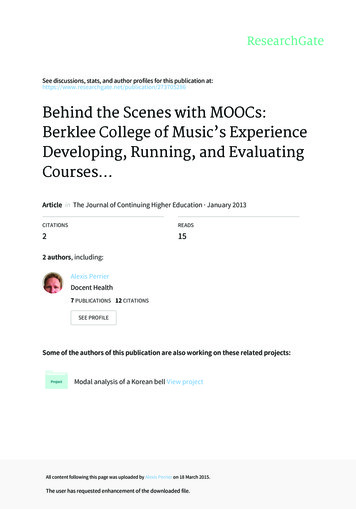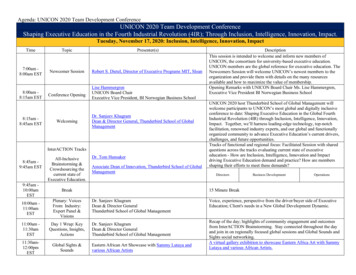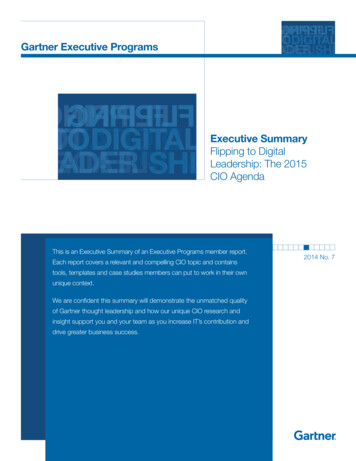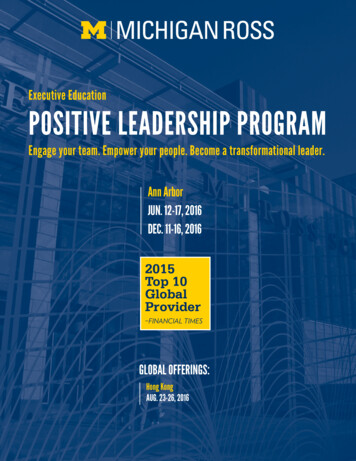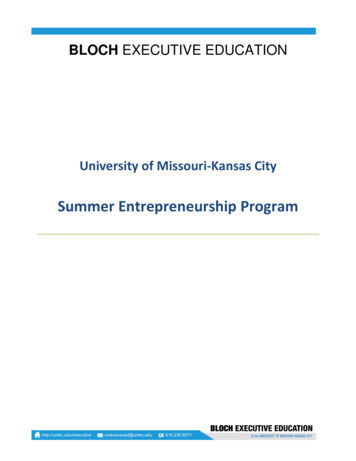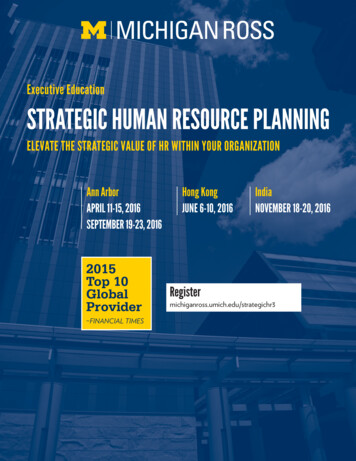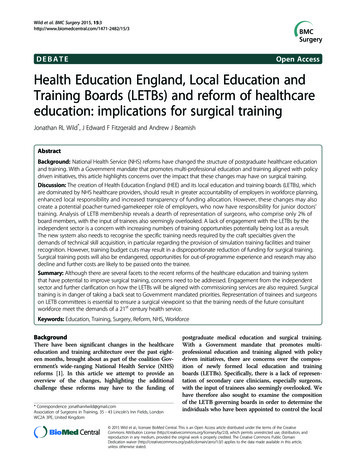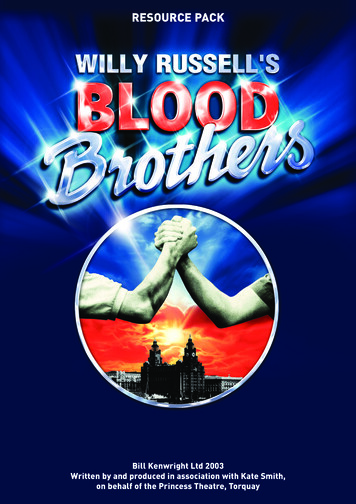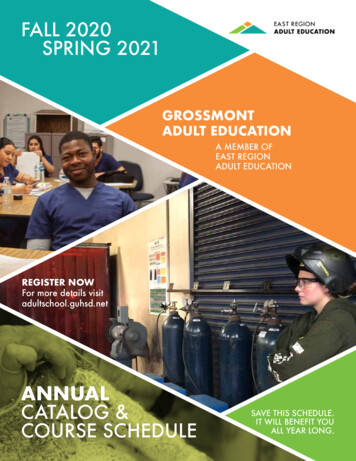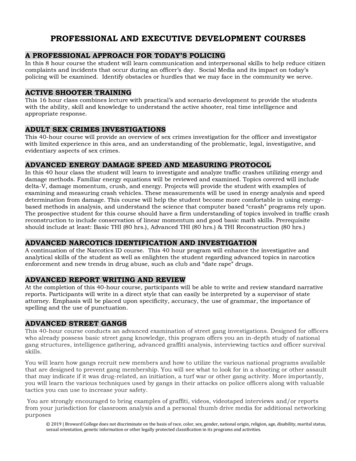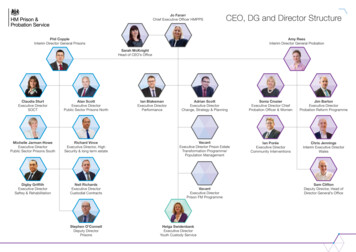Transcription
MOOCs and Executive EducationJennifer Kay Stine, Ph.D.Research Report Prepared forUNICONDirectors Conference April 2013#UNICON20131
Session Overview EnvironmentHistory‘Disruptiveness’Players, Stakeholders and Business ModelsWhat This Means for Exec. Ed.Survey ResultsQ/A, Your Thoughts and SuggestionsMOOCs andExecutive EducationStineSlide 2
What’s the big deal? Education (courses certificates credit? degrees?)at scale MOOC: Massively Open Online Course––––––Free (mostly)Semester-long (changing)Online‘Innovative’World-class institutions and facultyOrder of magnitudeMOOCs andExecutive EducationStineSlide 3
Environment The cost of a college education continues to be in the US nationalspotlight– Since 1985 the cost of a college education has increased more than500% (while the consumer price index increased 115%)*– US student loan debt exceeds credit card debt Global internet and broadband access has increased greatly– 2011: 2.26B internet users, 589 million with fixed wire broadband(5.9B with mobile-cellular and 1.6B with active mobile broadbandsubscriptions) **– This is a greater than 500% increase since 2000, when global internetusers numbered 361K.**** /college-costs-are-soaring/** -broadband-2012.pdf*** http://www.internetworldstats.com/stats.htmMOOCs andExecutive EducationStineSlide 4
Online Education Has Grown Steadily Over 6.7 million students were taking at least one online course during thefall 2011 term, an increase of 570,000 students over the previous year.Thirty-two percent of higher education students now take at least onecourse online.The proportion of chief academic leaders that say that online learning iscritical to their long-term strategy is at a new high of 69.1 percent (50% in2002)To date, MOOCs are a very small part of this market– 2.6 percent of higher education institutions currently have a MOOC (MassiveOpen Online Course), another 9.4 percent report MOOCs are in the planningstages.Changing Course: Ten Years of Tracking Online Education in the United /changingcourse.pdfMOOCs andExecutive EducationStineSlide 5
A Brief Timeline of Distance Learning InnovationsMOOCs andExecutive EducationStineSlide 61862 Pitman Shorthandtraining program broughtcutting edgestenography via US Mail1980s satellite televisionsystems became costeffective for employeetraining and wereembraced by industry1985, NationalTechnological University(NTU) started offeringdegree courses toemployees atcorporations and labs1892 U. of Chicagocreated first college-leveldistance learningprogram1970, Coastline Collegethe first without aphysical campus1993, Jones Universityoffered online instructionin 5 bachelors and 24masters, and wasaccredited by the HigherLearning Commission1923 ICS, started in1890 to teach minesafety, had enrolled over2.5M students1964, U. of WI, fundedby Carnegie created theAIM project to identifyand systematizedistance learningpractices, includingmultimedia2002, MIT launchesOpenCourseWare inresponse to Fathom.comand other initiatives1921-1946 FCC grantsradio licenses to over200 colleges (only onecourse offered by 1940)1934 U. of Iowabroadcast courses bytelevision2005, WebCT andBlackboard mergedunder Blackboard and “A Journeyto Legitimacy:The HistoricalDevelopment ofDistanceEducationthroughTechnology” byD. Casey
Clay Christensen Weighs In On Disruption: The question is not just whether MOOCs are going to disrupttraditional education, but how . MOOCs do bear the earlyhallmarks of a disruptive innovation:– Serves non-consumers– Marches upmarket– Redefines quality We believe they are likely to evolve into a “scale business”: one thatrelies on the technology and data backbone of the medium tooptimize and individualize learning opportunities for millions ofstudents. universities are likely investing in MOOCs now because disruptiontheory is finally widely enough understood that astute leaders knowhow to identify and chase opportunities the-mooc-buzz-where-are-they-going-really/MOOCs andExecutive EducationStineSlide 7
Christensen’s Predictions over time, an approach where users exchange information from eachother similar to Facebook (a “facilitated network model”) will come todominate online learning. likely to happen if the traditional degree becomes irrelevant and, asmany predict,* learning becomes a continuous, on-the-job learningprocess the need for customization will drive us toward just-in-timemini-courses.In this case, facilitated networks or adaptive learning platforms — like KhanAcademy and Knewton — may actually be better positioned than MOOCs– not unlike what happened in the car industry: The Ford Model T dominated theAmerican car market until General Motors brought forth choice and d-the-mooc-buzz-where-are-they-going-really/N. Harden, “The End of the University as We Know It,” In fifty years, if not much sooner, half of the roughly 4,500 colleges anduniversities now operating in the United States will have ceased to exist. ece 1352MOOCs andExecutive EducationStineSlide 8
Morten T. Hansen Weighs in On Exec Ed maybe just 10% of the executiveeducation market is "safe" it will upend the rest of the market afew star professors who deliver thecontent online (the Khan's of the execed market) a hoard of "lower-level" local instructorswho will help with the breakouts. The traditional exec ed professor will besqueezed out.http://blogs.hbr.org/cs/2013/01/executive education is ripe fo.htmlMOOCs andExecutive EducationStineSlide 9
Hansen’s Drivers Many companies have online learning platforms they need contentfor, creating demand; Spending a week in an exec ed program is consuming so much timethat alternatives such as a hybrid online program look attractive; Ever-better technologies make the online experience moreappealing; Pressures on cost will lead to more adoption of online exec ed; Another reason for getting people together in an exec ed program —that of networking — can be done through online networking tool, sowhy meet?http://blogs.hbr.org/cs/2013/01/executive education is ripe fo.htmlMOOCs andExecutive EducationStineSlide 10
US Provost ovostsMOOCs andExecutive EducationStineSlide 11
US Provost rovostsMOOCs andExecutive EducationStineSlide 12
Major MOOC PlayersUdacityCourseraedXUdemy Thrun(Stanford) For profit, 2012 21M venturefunding 400K students 23 courses Select faculty 160K in one course(AI, 2011) Ng & Koller(Stanford) For profit, 2012 22M venturefunding 3.1M students 329 courses 62 universities 180K in one course(Philosophy, 2012) Argwal(MIT) Nonprofit, 2012 60M funds, grants,gifts 600K students* 33 courses 12 universities 160K in one course(Circuits, 2012) Paid course platform,with some free For profit, 2010 15M, Series A & Bfunding in ‘11, ‘12 600K registered 6000 courses Individual faculty Generated 15Msince launch Top faculty earn 500K* 370K uniquelearners inOct 2012MOOCs andExecutive EducationStineSlide 13
Some Related InitiativesVenture Lab (Stanford)Innovators Accelerator (U. of Phoenix, Christensen, Ideo)Thunderbird-Laureate PartnershipKhan AcademyFuturelearn (The Open University)Knight Center for Journalism (UT Austin)iTunes UniversityOpenCourseWare and other Open Resources including textbooks and articlesMOOCs andExecutive EducationStineSlide 14
Activities leContent Development & Delivery (inc. �Udemy*FacultyContent CreationFacultySpecialists/Consultants*more than 10,000 people have taken Udemy’s course on how to design and teach a Udemy courseMOOCs andExecutive EducationStineSlide 15
Business Models are Emerging Corporate recruiting (job referrals, sponsored classes) Educational outsourcing/licensing of platforms, courses, content ‘Freemium’: Fee-for-certificate and/or credit and/or identityverification; also some free (independent), some fee (academic) Channeling participants into subsequent for-fee courses andprograms 424127887324339204578173421673664106.html?mod googlenews wsjMOOCs andExecutive EducationStineSlide 16
Potential University ImpactsOrganizationalEducational MethodsDisciplines and Subjects Data-driven innovation andimprovements Mass personalization Peer learning and support ‘Flipped classrooms’ New partnerships FinancialCredit/CredentialingAudience True cost calculations Reliance on ‘free’ software Scaling allows for different models( 0.99 app) Increased competition Downward pressure on tuition,fees ResourcesFaculty dutiesFaculty governanceComplianceOptimization and cost savingsScaleMOOCs andExecutive EducationStineSlide 17Assessing learningPrior learning activitiesEnhanced student mobilityAgency involvement (ACE,regional accreditation)Smaller modulesTechnical and humanitiesSkills-based and developmentalAcademic and general interestConflict of commitment14 to 77Lifelong learnersFocus on campus educationProfessional / continuingeducation
Faculty are an Important DriverProf. Mike Lenox, UVA Darden, “Foundations of Business Strategy” 6-weekMOOC delivered on Coursera, March 2013, 90,000 enrolled: As a teacher, I have been thrilled to see the reach and impact of my MOOC,Foundations of Business Strategy.– Students from over 50 countries are participating including students fromthe Philippines, Australia, Rwanda, Croatia, UAE, Mexico, Egypt and Argentinaamong many others.– I will have taught more than 5x as many students in a six week period than havegraduated from the Darden School over its entire 50-year plus existence.– Every day, I receive thanks from students for the opportunity to take the course –many who are applying the concepts in their working lives as they take thecourse and who otherwise would not have access to such nd-highereducation/MOOCs andExecutive EducationStineSlide 18
That said, Lenox points out: my MOOC does not replicate the Darden classroom experienceat a Socratic case-based school like Darden, we have been flipping theclassroom for over 50 yearslearning that emerges from an engaged, real-time discussion cannot bereplicated on an online forum.the fear, and triumph, of presenting your ideas for scrutiny often at thebequest of the faculty member (what we refer to as a “cold call”) is apowerful learning experiencethis type of engagement cannot be conducted asynchronously and it cannotbe scaledNote: not all faculty active in MOOCs make this -and-highereducation/MOOCs andExecutive EducationStineSlide 19
Lenox predicts market bifurcation: A cost leader (or leaders) will emerge catering to the mass market.––– They will leverage technology to provide an effective and efficient education. They will cater to thepopulation who may not have had access to higher education thirty years ago.The emergence of the cost leader position will be bad news for the many for-profit online universitiesthat have arisen in recent years and for numerous non-selective residential universities. This is where theshakeout will be most disruptive.This disruption will play out over years, if not decades, as struggling colleges fight to stay alive and studentattitudes towards online education evolve.Retrenchment and growth of a group of elite differentiated players who compete globally for thebest students.–––––They will emphasize the benefits of a residential education and they will charge significant tuition premiums.They will be highly selective and highly sought after.Some will adopt niche positions catering to elite students of one type or another.They will leverage technology, but as a way to improve the efficacy of their residential programs.They will dabble in MOOCs, not as a source of significant revenue generation, but as a way to enhance theirglobal brand and reach.http://www.forbes.com/sThe question for a traditional university will be which of these worlds it will sort.MOOCs andExecutive EducationStineSlide uptive-innovationand-higher-education/
What About Our Audiences andPrograms?MOOCs andExecutive EducationStineSlide 21
Exec. Ed. Interviews Broad agreement this is a rapidly changing landscape and it is difficult topredict the futureOpportunity for innovation, staying ahead of curve – including capitalizingon press attentionOpportunities to extend blended learning activities and possibly onlinelearning in organizations– Deepening engagement at scaleSeveral institutions actively working on strategies – work not completeLikely near-term threat is to open enrollment (not custom) and skills-basedtopics (not leadership or strategy)–Finance for Non-financial Mangers?MOOCs andExecutive EducationStineSlide 22
UNICON Survey (March 2013) Sent to 13,000 past participants of executive education programs from fiveinstitutions– Of these, 676 responses (5% response rate; range 2.5% to 7.3%)– 241 (36%) of these responses were to a Spanish-language surveyGeographic location: 61 countries represented (English, n 414)––– MIT, Columbia, INSEAD, ITAM, University of Alberta39% of respondents reside in the US,7% in Mexico, and3% each in France, Brazil, Switzerland, Canada, Germany, followed by 2% each Australia,Japan.Age (English, n 417)–––67% of respondents were between ages 30 and 49.26% were aged 50-59.Under 30 and over 60 were 3% each, respectivelyMOOCs andExecutive EducationStineSlide 23
Value of Online vs. In-Person English-language survey participants split in support for face-to-faceversus blended learning (n 433)MOOCs andExecutive EducationStineSlide 24
Value of Online vs. In-Person Spanish language responses weighted somewhat more towardsblended and less face-to-face (n 238)MOOCs andExecutive EducationStineSlide 25
Why Enroll in Online? Lower-cost online options are attractive, but they don’t have to be freeCertification is of interestCourse credit mattered more in the Spanish-language surveyW hi c h o f the fo l l o wi ng c o nd i ti o ns wo ul d m a k e y o u M OR El i k e l y to e nro l l i n a n o nl i ne E xe c uti v e E d uc a ti o np ro g ra m ? (c he c k a l l tha t a p p l y )A ns we r Op ti o nsIt is lower cost than a similar face-to-face programIt offers certification in a fieldI receive academic, graduate-level, or course creditMy company sponsors my participationIt offers a general certificate of completionIt is freeIt could help me with a promotion(English, n 420, Spanish n 238)MOOCs andExecutive EducationStineSlide 26R e s p o ns eP e rc e ntE ng l i s h45.5%44.0%41.2%34.8%29.5%24.0%23.8%R e s p o ns eP e rc e ntS p a ni s h47.5%39.9%66.0%30.7%48.7%17.6%26.9%
Experiences to Date Most respondents had taken self-paced online training (n 346, Spanishdata similar)MOOCs andExecutive EducationStineSlide 27
MOOC-type, specifically Participation infree universitycoursesrelatively lowAwareness ofMOOCs wasabout 30%(n 351)– 94% ofSpanishwereunaware offreeuniversitycoursesMOOCs andExecutive EducationStineSlide 28In the p a s t y e a r, ha v e y o u e nro lle din a fre e s e me s te r-lo ng c o urs eo ffe re d b y a univ e rs ity ? (c he c k a lltha t a p p ly )R e s p o ns eP e rc e ntE ng lis hR e s p o ns eP e rc e ntS p a nis hCourseraUdacityedXKahn 0.5%I don't have time to do these coursesI am not interested in these coursesI have never heard of these courses16.5%8.3%69.2%2.0%2.0%93.5%A ns we r Op tio ns
Completion rates For those who did enroll in free online courses (n 130), thecompletion rates were relatively high (54%)– MOOC completion rates about 7%MOOCs andExecutive EducationStineSlide 29
Suitability 52.1% of English-language respondents felt online was highly or well suitedfor executive education (n 417)MOOCs andExecutive EducationStineSlide 30
Suitability An even higher percentage (67.7%) of Spanish-language respondents felt itwas very well or well suited (n 192)MOOCs andExecutive EducationStineSlide 31
Why or Why Not Learn Online? 228 (English) chose to comment on why or why not.––––Saving time was critical, as was qualityTravel costs were frequently citedNetworking and interactive learning were importantSome subjects and goals were considered more appropriate for online thanothers– Many felt like a combination of face-to-face and online provided the best optionMOOCs andExecutive EducationStineSlide 32
OnlineHighly orWell Suited –Open ResponseWord Frequency(n 113):MOOCs andExecutive EducationStineSlide 33
OnlineNot Well orPoorly Suited –Open ResponseWord Frequency(n 53):MOOCs andExecutive EducationStineSlide 34
Some Thoughts and Take-Aways Change won’t happen overnight, but it is happeningImportant space to watch / explore for learning and delivery innovationsSpace where you can support your clients––– StrategyUnmet needsBlended learning (meeting customer needs preserving margins)Implications of global reach not clear – may be a larger force than thosecurrently in playCost implications not clear – quality education remains expensiveThink from your faculty members’ point of viewUltimately, who will serve broader populations? Other than publishers, littleeducation at scale today: will that change?MOOCs andExecutive EducationStineSlide 35
Additions? Reflections? Questions?MOOCs andExecutive EducationStineSlide 36
Morten T. Hansen Weighs in On Exec Ed maybe just 10% of the executive education market is "safe" it will upend the rest of the market a few star professors who deliver the content online (the Khan's of the exec ed market) a hoard of "lower-l
